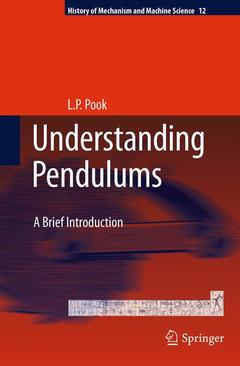Understanding Pendulums, 2011 A Brief Introduction History of Mechanism and Machine Science Series, Vol. 12
Auteur : Pook L.P.

Despite their apparent simplicity, the behaviour of pendulums can be remarkably complicated. Historically, pendulums for specific purposes have been developed using a combination of simplified theory and trial and error. There do not appear to be any introductory books on pendulums, written at an intermediate level, and covering a wide range of topics. This book aims to fill the gap. It is written for readers with some background in elementary geometry, algebra, trigonometry and calculus. Historical information, where available and useful for the understanding of various types of pendulum and their applications, is included.
Perhaps the best known use of pendulums is as the basis of clocks in which a pendulum controls the rate at which the clock runs. Interest in theoretical and practical aspects of pendulums, as applied to clocks, goes back more than four centuries. The concept of simple pendulums, which are idealised versions of real pendulums is introduced. The application of pendulums to clocks is described, with detailed discussion of the effect of inevitable differences between real pendulums and simple pendulums. In a clock, the objective is to ensure that the pendulum controls the timekeeping. However, pendulums are sometimes driven, and how this affects their behaviour is described. Pendulums are sometimes used for occult purposes. It is possible to explain some apparently occult results by using modern pendulum theory. For example, why a ring suspended inside a wine glass, by a thread from a finger, eventually strikes the glass. Pendulums have a wide range of uses in scientific instruments, engineering, and entertainment. Some examples are given as case studies.
Indexed in the Book Citation Index? Science (BKCI-S)
Preface.- Notation.- 1 Introduction.- References.- 2 Simple Pendulums.- 2.1 Introduction.- 2.2 Simple Harmonic Motion.- 2.3 Analysis of a Simple Rod Pendulum.- 2.3.1 Acceleration due to Gravity.- 2.3.2 Accelerations of a Simple Rod Pendulum.- 2.3.3 Potential and Kinetic Energy of a Simple Rod Pendulum.- 2.3.4 Circular Error of a Simple Rod Pendulum.- 2.3.5 Effect of the Earth’s Curvature.- 2.4 Analysis of a Simple String Pendulum.- 2.5 Spherical Rod Pendulum.- References.- 3 Variations on Simple Pendulums.- 3.1 Introduction.- 3.2 Compound Pendulum.- 3.3 Double Rod Pendulum.- 3.4 Blackburn Pendulum.- 3.5 Bifilar Pendulum.- 3.6 Rotating Simple Rod Pendulum.- 3.7 Quadrifilar Pendulum.- 3.7.1 Dual String Pendulum.- 3.8 Trapezium Pendulum.- 3.8.1 Dual Rod Pendulum.- 3.9 Double String Pendulum.- References.- 4 Pendulum Clocks.- 4.1 Introduction.- 4.2 Pendulum Quality Q.- 4.2.1 Damped Simple Harmonic Motion.- 4.2.2 Definition of Q.- 4.3 Buoyancy.- 4.4 Suspensions and Modes of Oscillation.- 4.4.1 Spring Suspensions.- 4.4.2 Pivot Suspensions.- 4.4.3 Knife Edge Suspensions.- 4.5 Effects of Escapements.- 4.6 Reduction of Effects of Circular Error.- References.- 5 Driven Pendulums.- 5.1 Introduction.- 5.2 Random Process Theory.- 5.2.1 Bandwidth.- 5.3 Driven Damped Simple Harmonic Motion.- 5.3.1 Periodic Driving.- 5.3.2 Random Driving.- 5.4 Horizontal Driving of Pendulums.- 5.4.1 Periodic Driving.- 5.4.2 Random Driving.- 5.5 Occult Uses of Pendulums.- References.- 6 Scientific Instruments.- 6.1 Introduction.- 6.2 Kater’s Pendulum.- 6.3 Newton’s Cradle.- 6.3.1 Modes of Oscillation.- 6.3.2 Theoretical Analysis.- 6.4 The Foucault Pendulum.- 6.4.1 Essential Features.- 6.4.2 Pumping.- 6.4.3 Motions of the Bob.- 6.5 Charpy Impact Testing Machine.- References.- 7 Engineering.- 7.1 Introduction.- 7.2 WattSteam Governor.- 7.3 Cable Car.- 7.4 Tension Leg Platform.- References.- 8 Entertainment.- 8.1 Introduction.- 8.2 Child’s Swings.- 8.2.1 Pumping of Child’s Swings.- 8.3 Child’s Rocking Horse.- 8.4 Pendulum Harmonographs.- 8.5 Harmonograms and Pendulum Harmonographs.- 8.5.1 Lissajous Figures.- 8.5.2 Circular Harmony Curves.- 8.5.3 Miscellaneous Harmonograms.- 8.5.4 Some Practical Considerations.- References.- Index.
Leslie Philip (Les) Pook was born in Middlesex, England in 1935. He obtained a BSc in metallurgy from the University of London in 1956. He started his career at Hawker Siddeley Aviation Ltd, Coventry in 1956. In 1963 he moved to the National Engineering Laboratory, East Kilbride, Glasgow. In 1969, while at the National Engineering Laboratory, he obtained a PhD in mechanical engineering from the University of Strathclyde. Dr Pook moved to University College London in 1990. He retired formally in 1998 but remained professionally active in the fields of metal fatigue and fracture mechanics, and is affiliated to University College London as a visiting professor. He now has more tine to pursue long standing interests in recreational mathematics, including flexagons, and in horology. He is a Fellow of the Institution of Mechanical Engineers and a Fellow of the Institute of Materials, Minerals and Mining. Les married his wife Ann in 1960. They have a daughter, Stephanie, and a son, Adrian. His previous books are listed below.
Frost N E, Marsh K J and Pook L P. Metal fatigue. Oxford: Clarendon Press, 1974. ISBN 0 19 856114 8. Reprinted with minor corrections. Mineola, NY: Dover Publications Inc., 1999. ISBN 0-486-40927-9.
Pook L P. The role of crack growth in metal fatigue. London: Metals Society, 1983. ISBN 0 904357 63 5.
Pook L P. Linear elastic fracture mechanics for engineers. Theory and applications. Southampton: WIT Press, 2000. ISBN 1 85312 7035.
Pook L P. Crack paths. Southampton: WIT Press, 2002. ISBN 1-85312-927-5.
Pook L P. Flexagons inside out. Cambridge: Cambridge University Press, 2003. ISBN 0 521 81970 9 hardback 0 521 52574 8 paperback.
Pook L P. Metal Fatigue: What it is, why it matters. Dordrecht: Springer, 2007. ISBN 1-4020-5596-6.
Pook L P. Serious fun with flexagons. A compendium and guide. Dordrecht: Springer. To be published July 2009. ISBN 978-90-481-2502-9.
dy>Date de parution : 07-2013
Ouvrage de 136 p.
15.5x23.5 cm
Date de parution : 05-2011
Ouvrage de 136 p.
15.5x23.5 cm



